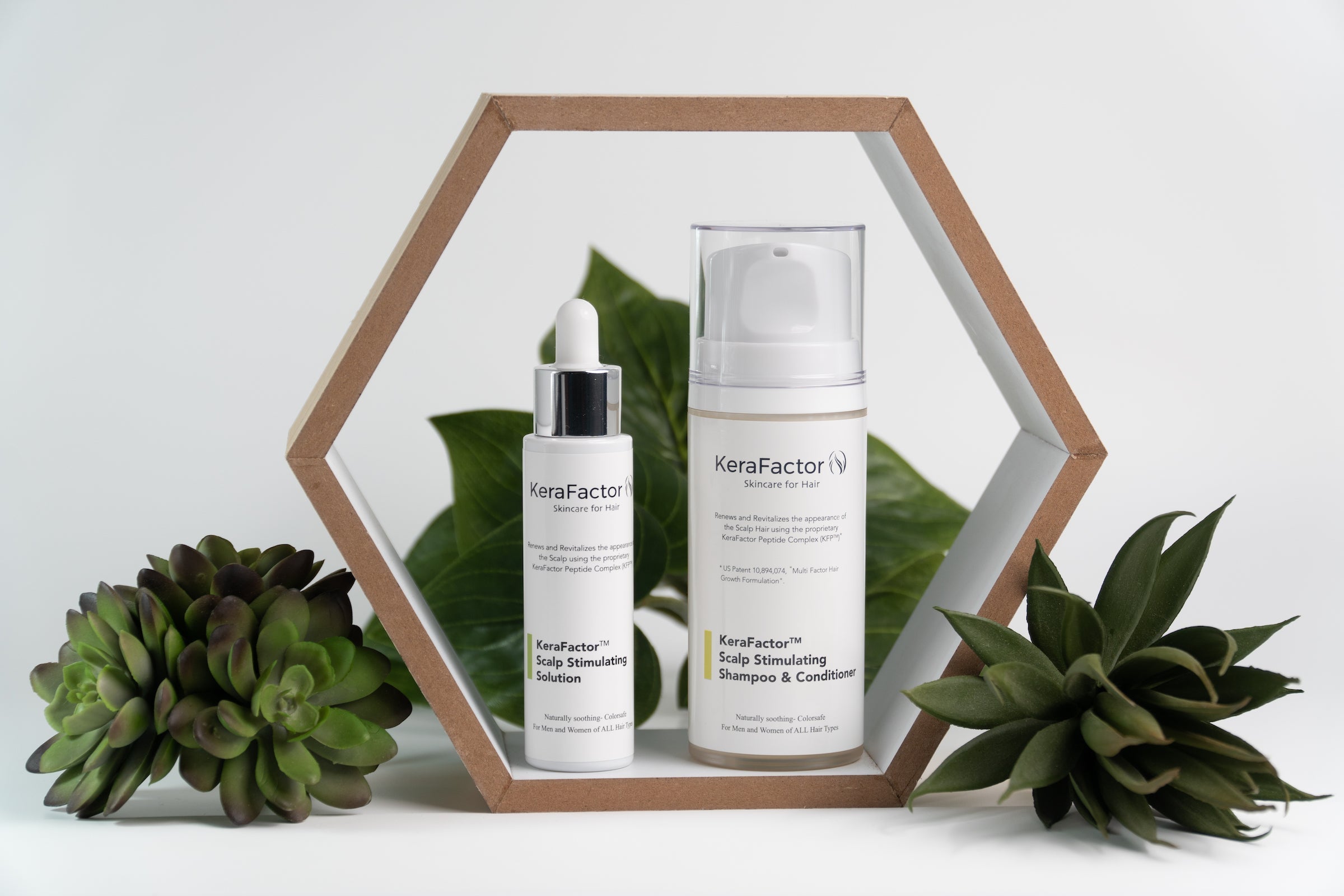PEOPLE ARE SEEING their dermatologists for more and more interesting technologies these days and we’re all about it. We pay attention to what’s happening in the aesthetics space, because some of this tech holds promise for future application in alternative medicine.
Over the last few years, both microneedling and laser have become an incredibly popular treatment for the face, but also now for the scalp. Notable derms like hair loss specialist, Dr. Craig Ziering and Dr. Karen Grossman both here in LA and in NYC are using microneedling and a laser treatment called KeraLase to deliver a peptide-rich complex called KeraFactor to the scalp to restore scalp health and encourage hair restoration.

We talked to the founders of KeraFactor, Amy Forman Taub, MD, FAAD and James Bartholomeusz about their peptide complex, why it’s become so popular in these high-tech treatments, and how to effectively use their solution at home for those of us who aren’t ready to hit the doctor’s office…
While both have multiple different biological functions, we’re utilizing specific peptides with biological functions that are advantageous for hair growth.
James Bartholomeusz: For KeraFactor, we synthetically manufactured very specific peptides to the exact concentration needed to be effective in the scalp. Not to get too science-y here, but we also wrap those peptides in individual nanoliposome for the most optimal absorption possible.
It took years of testing and technological advancements to develop our final KeraFactor products. My personal journey started in 2012 when I started experiencing dramatic hair loss myself. My own needs led me to research as much as I could about the multiple causes of loss and looking into various growth factors like peptides. That’s how we discovered the approach we use with KeraFactor now.
TCM: 95% of our hair is keratin protein. Anything that damages keratin is also dangerous for general hair growth, correct? How does KeraFactor behave in relationship with keratin production?
James Bartholomeusz: There is a specific polypeptide to address the secretion of keratin. And there are key growth factors that influence the health and circulatory system of the scalp. In turn, those factors increase the flow of blood and other nutrients to the hair to support keratin.
Dr. Amy Taub: Yes, the specific growth factor that stimulates the production of keratin leads to a thickening of the hair diameter specifically.
TCM: What kind of in-office results are you and the dermatologists you’re working with seeing?
Dr. Amy Taub: The in-office results are there, but we’re actually seeing great results from the at-home use of KeraFactor. Later, some of our customers are adding those in-office procedures to jumpstart the process of hair regrowth which can be slow and frustrating if you’re really determined to see quick results.
KeraFactor can be delivered to the scalp at home and then also in a concentrated sterile solution immediately after laser microdermabrasion or micro-needling.


Client Before & After 2 Treatments
James Bartholomeusz: We’re especially excited about the laser-assisted delivery of KeraFactor, an in-office treatment called KeraLase. We’re finding that it provides much needed resurfacing and remodeling of the scalp with less discomfort and no open wounds that need to heal unlike microneedling.
TCM: You’ve mentioned that dermatologists are seeing a dramatic increase in hair loss and poor scalp health patients. I’m sure you could attribute that to many factors, but which factors are of note?
Dr. Amy Taub: There has definitely been an increase in stress-related hair loss during the pandemic, but I don’t believe the incidence of androgenetic alopecia (which is due to genetics) has increased.
I believe the main factor causing this increase is the way we’re shifting our thinking about age. More of us are healthy into older age and are more interested in our appearance than past generations were. That means more of us are solving for hair loss issues that previous generations may have just accepted. The key is in understanding that treatments exist that can improve the hair and scalp.
TCM: We know your team is on board with a holistic approach to dermatology and hair health. If someone is suffering from hair loss, what are a few of the most important lifestyle factors you would advise them to look at?
Dr. Amy Taub: Nutrition plays a big role in our overall well-being and hair health is no different. That said, you can have the best diet in the world and still have hair loss.
One key nutrient missing from many modern diets is iron. The body needs iron daily for healthy hair growth and our bodies can become depleted if iron isn’t replaced through diet. So many people have become vegan or are eating less red meat. For those individuals, it is important to ensure that you’re getting a daily allowance of iron in your diet or taking an iron supplement.
Stress may also be a big factor in hair loss, but is very difficult to control. Some nutraceuticals use anti-stress and antioxidant ingredients to try to mitigate the effects of stress which could be helpful to some.
TCM: Let’s talk about using your solution at home. Of course, we can’t implement lasers or microneedling, but how do you recommend we use it?
James Bartholomeusz: Actually, there is an at-home combination approach that involves laser! Similar to the LED face masks that have become so popular, a lot of our customers are combining KeraFactor with an LED laser cap. This helps increase absorption of the KeraFactor Solution and the cap itself can drastically improve scalp circulation for scalp health and hair growth.
Dr. Amy Taub: To use KeraFactor solution at home, you would apply at least a dropperful of solution to the affected areas of the scalp twice a day. Rub the solution in vigorously with your fingers.
Alternatively, we offer a scalp stimulating shampoo and conditioner. For that treatment, you would use the shampoo/conditioner once a day, letting it sit for one minute while you shower. Then apply the KeraFactor solution in the evening.

We have many many patients who feel it has helped them and many who receive in-office treatments on top of this routine to boost their results. On average, we’re seeing results at about three month, but it can take anywhere from 6 weeks to 6 months to notice improvement.
On a personal note, my son unfortunately started losing hair on the top of his head while in his 20’s. He started using KeraFactor at home and it has filled in. He stopped using it for a couple of months and it started to appear worse again. He restarted and it worked again. It requires maintenance to get those consistent results.
I also use it myself. As an aging woman, my hair was thinning and I hated seeing my scalp through my hair. I no longer look in the mirror and stress over the lack of hair coverage.
This story is brought to you in partnership with KeraFactor. From time to time, TCM editors choose to partner with brands we believe in to bring our readers special offers. These statements have not been evaluated by the Food and Drug Administration. The Chalkboard Mag and its materials are not intended to treat, diagnose, cure or prevent any disease. All material on The Chalkboard Mag is provided for educational purposes only. Always seek the advice of your physician or another qualified healthcare provider for any questions you have regarding a medical condition, and before undertaking any diet, exercise or other health-related programs.




